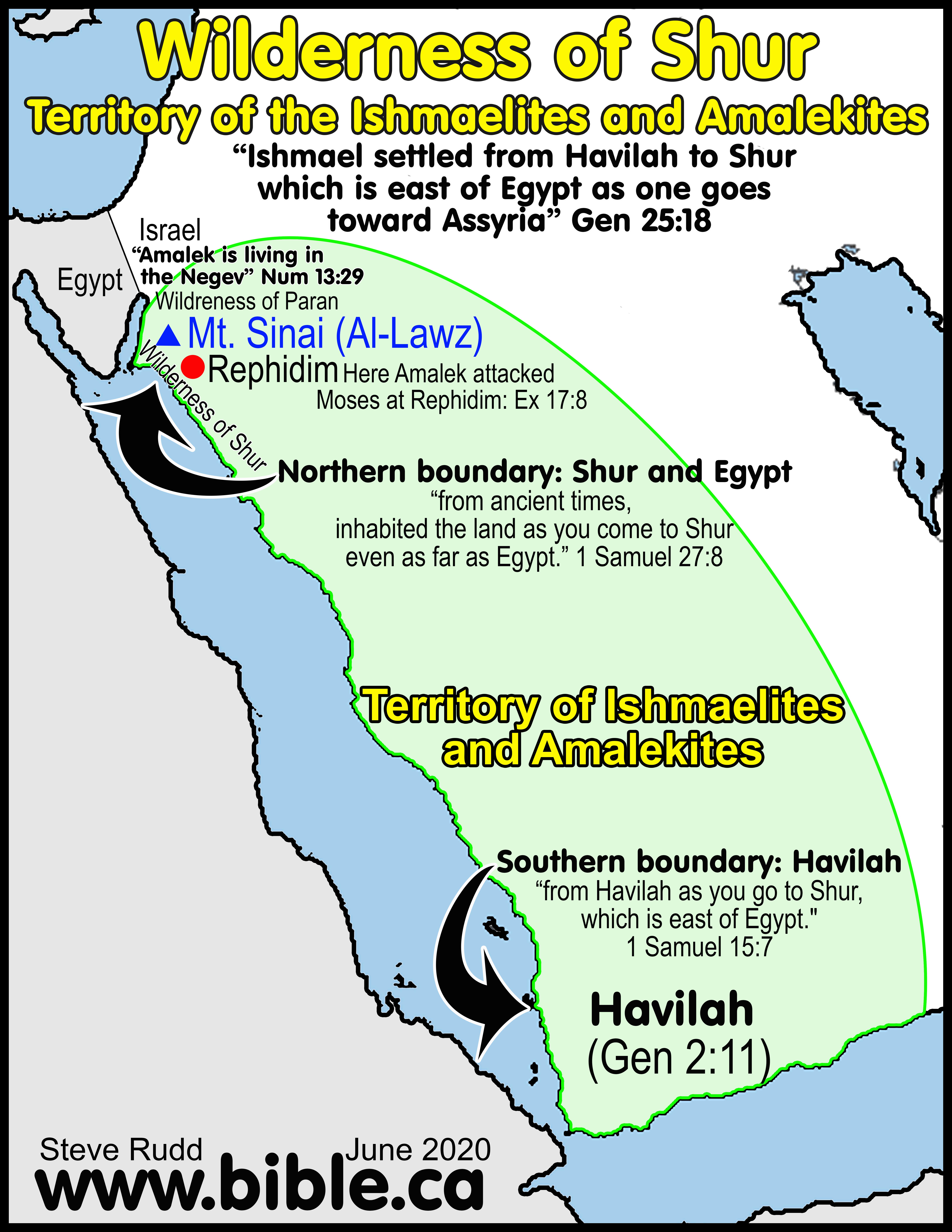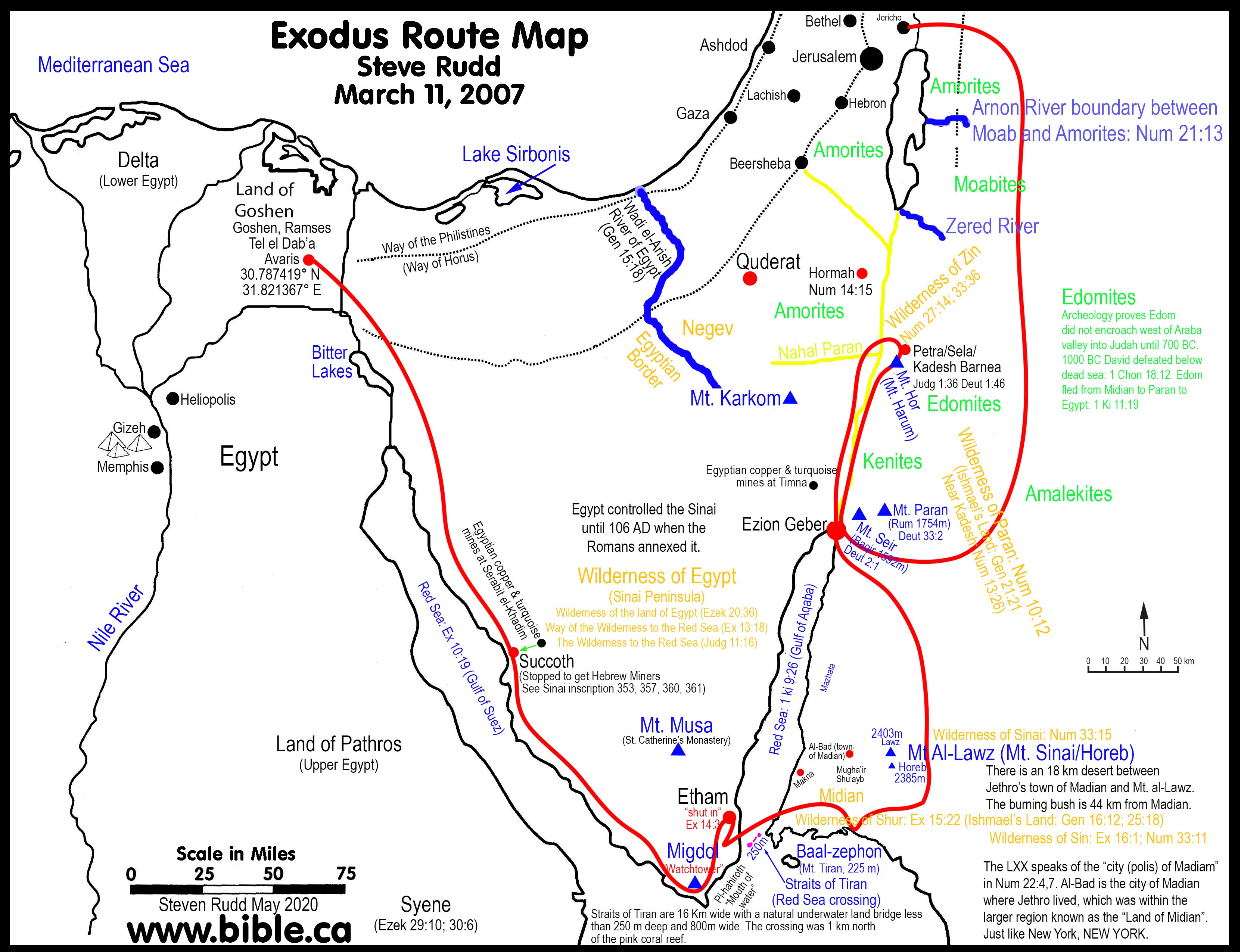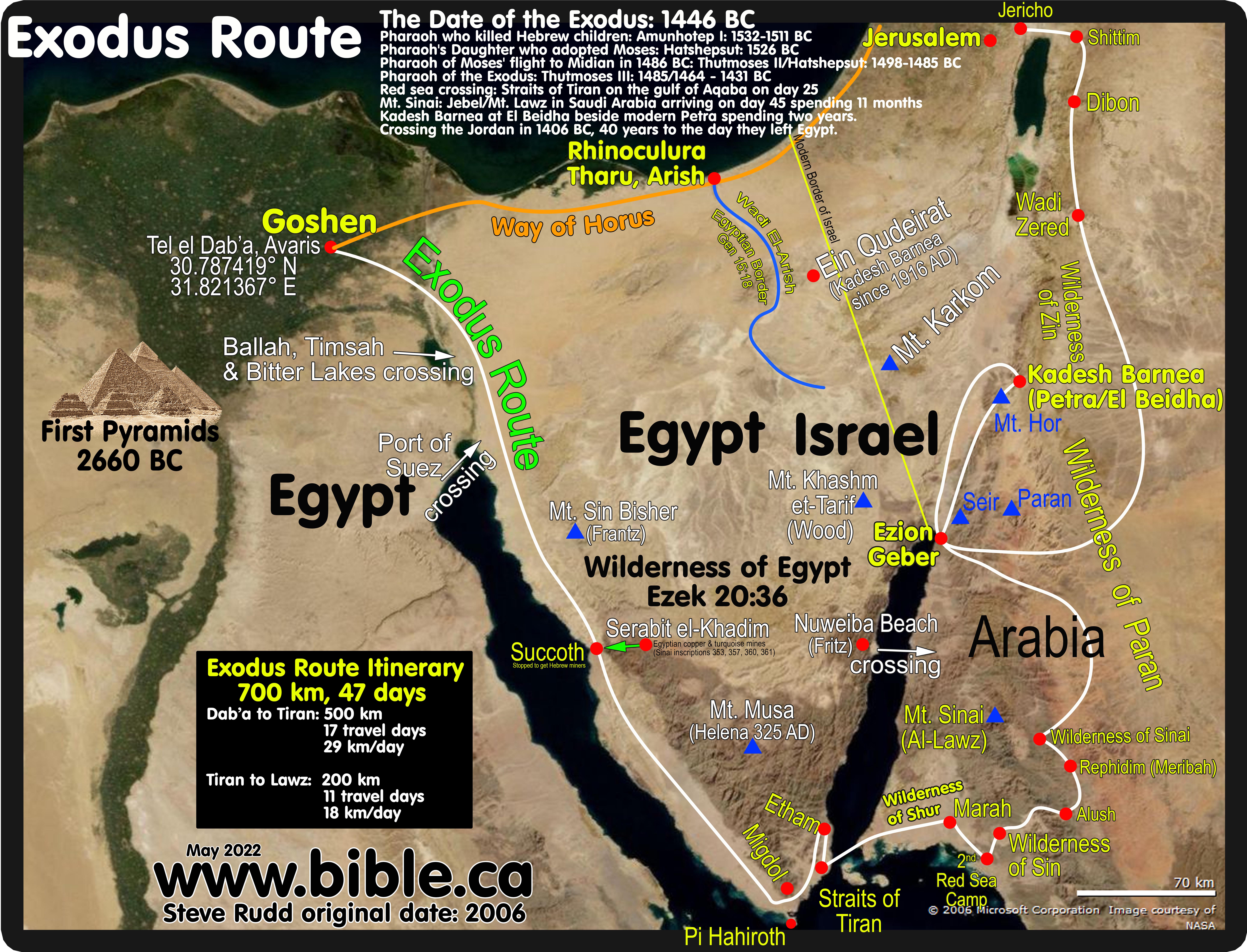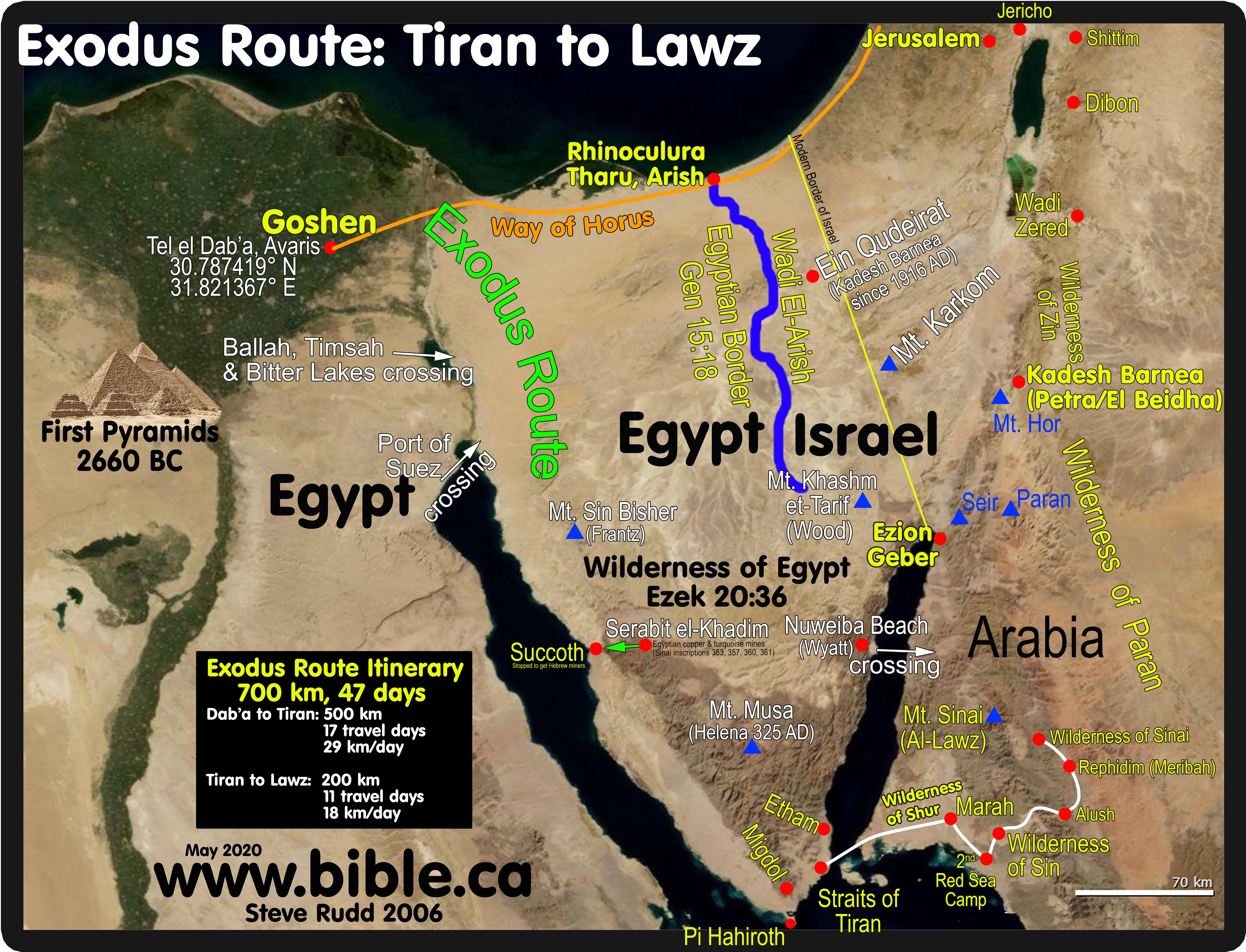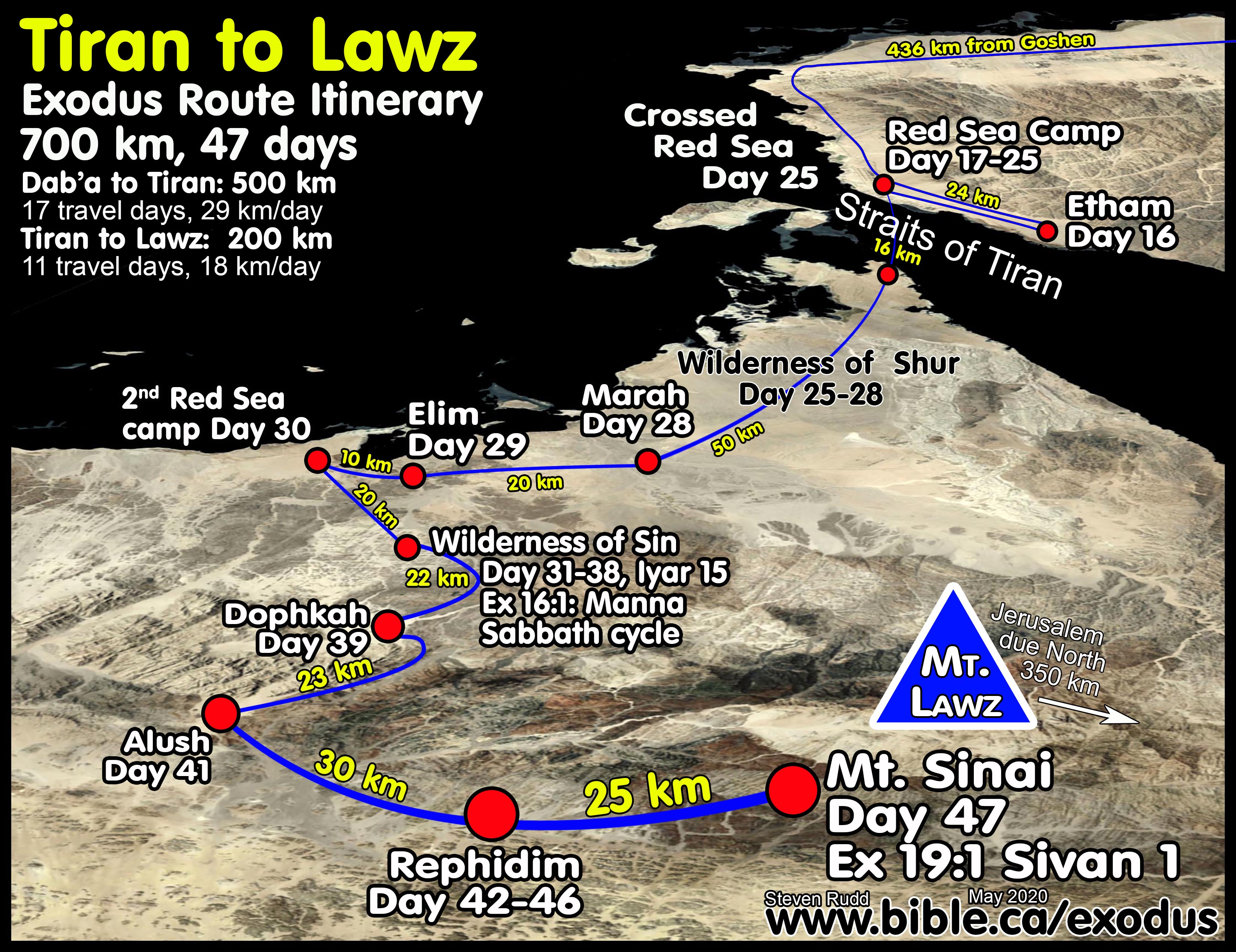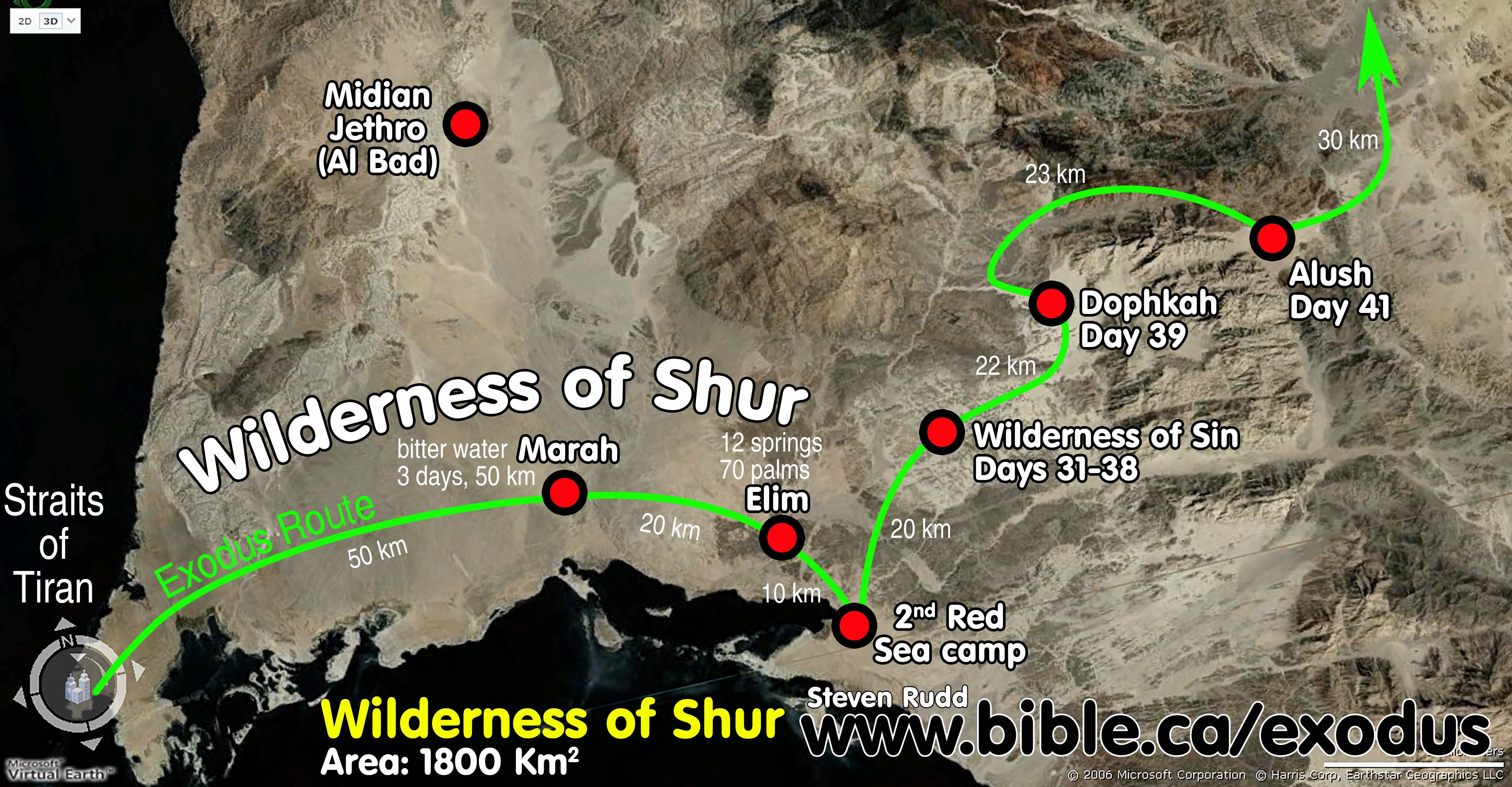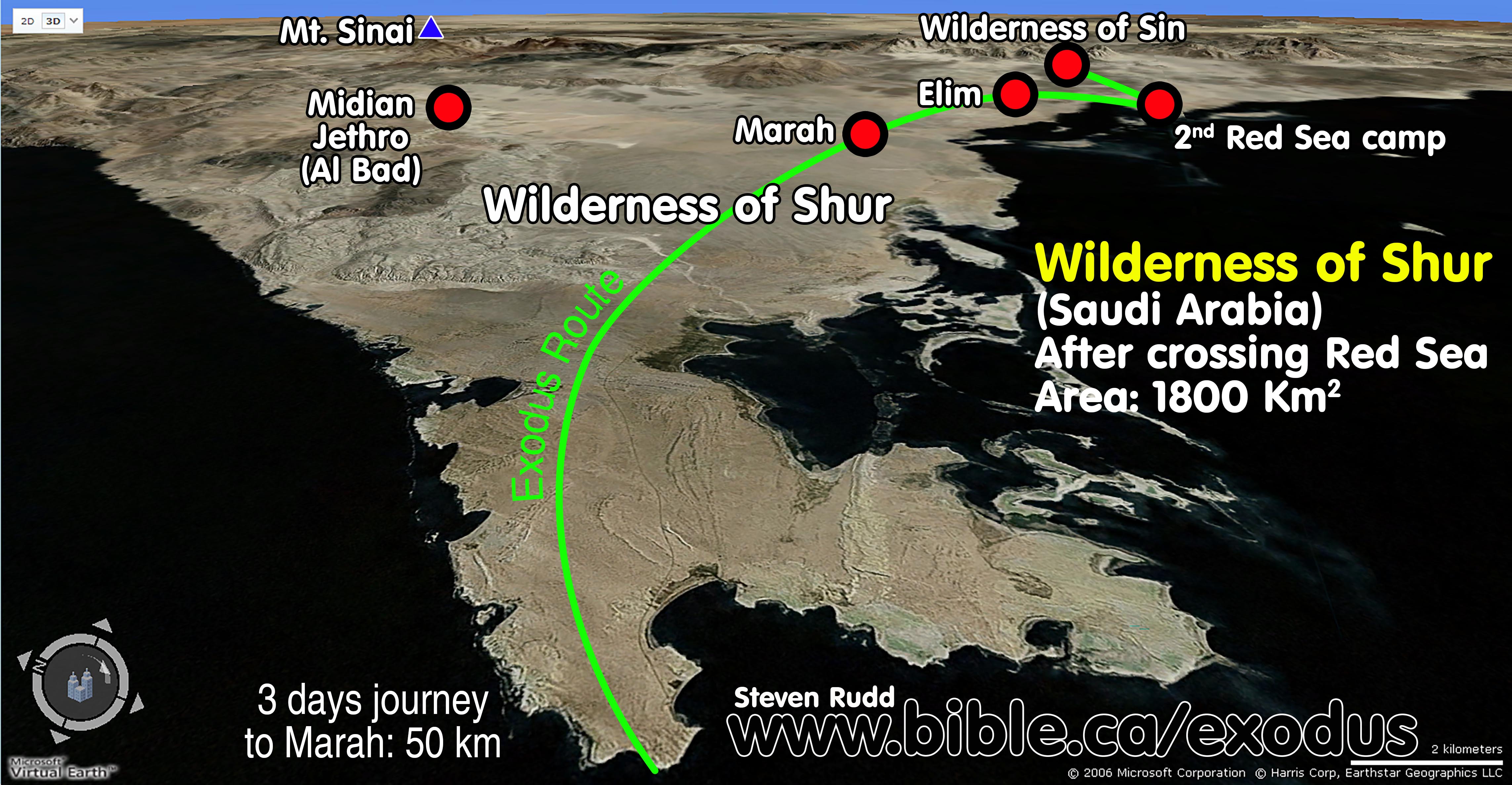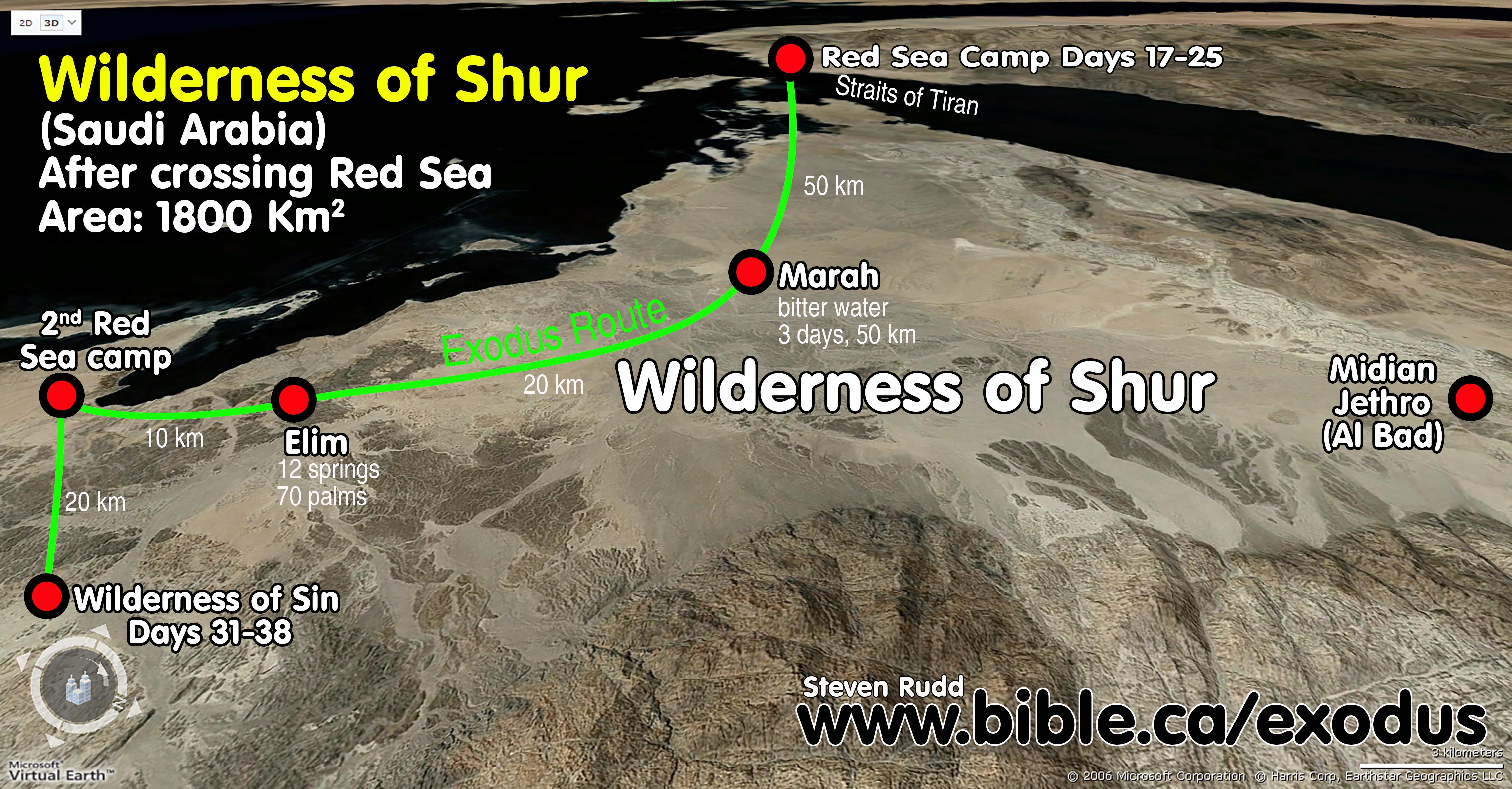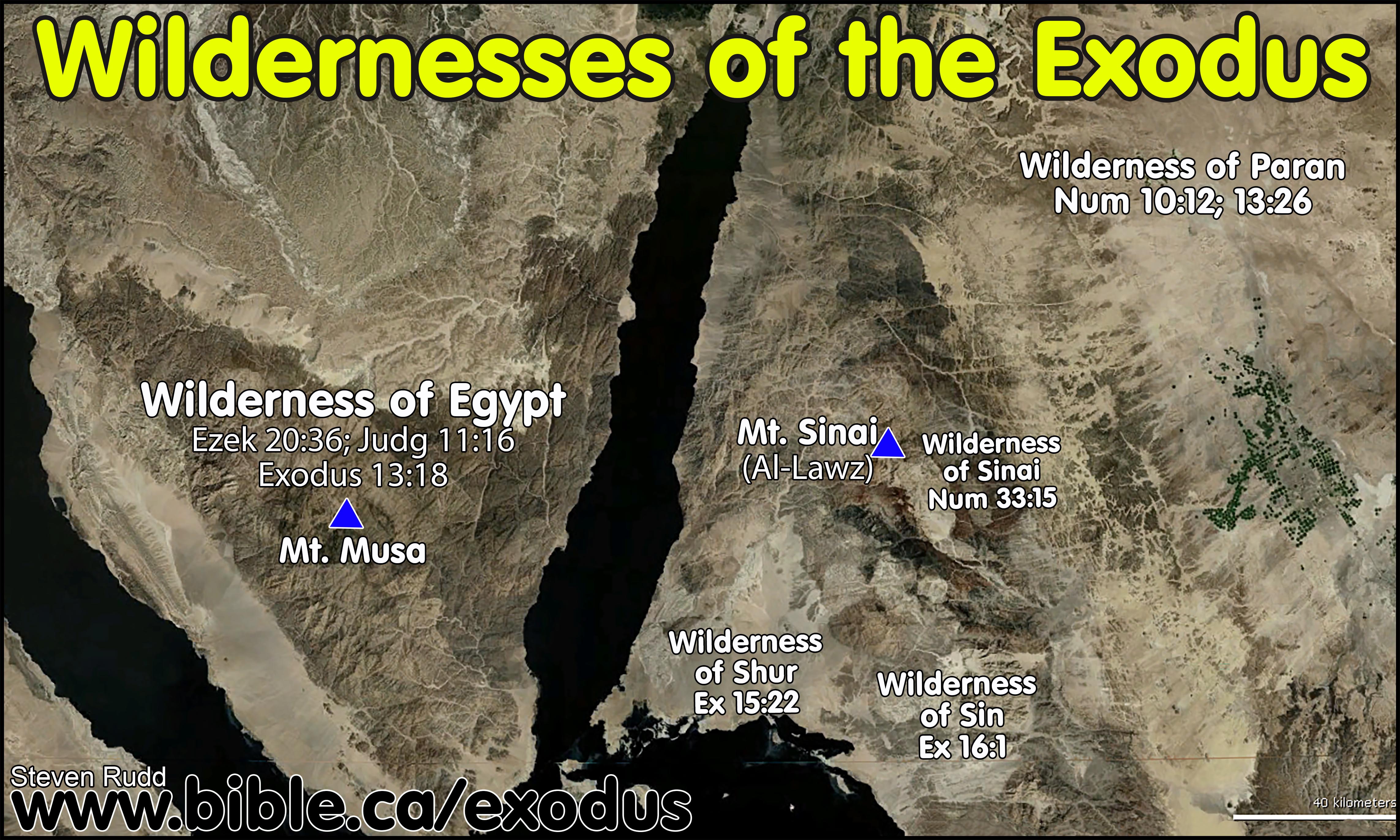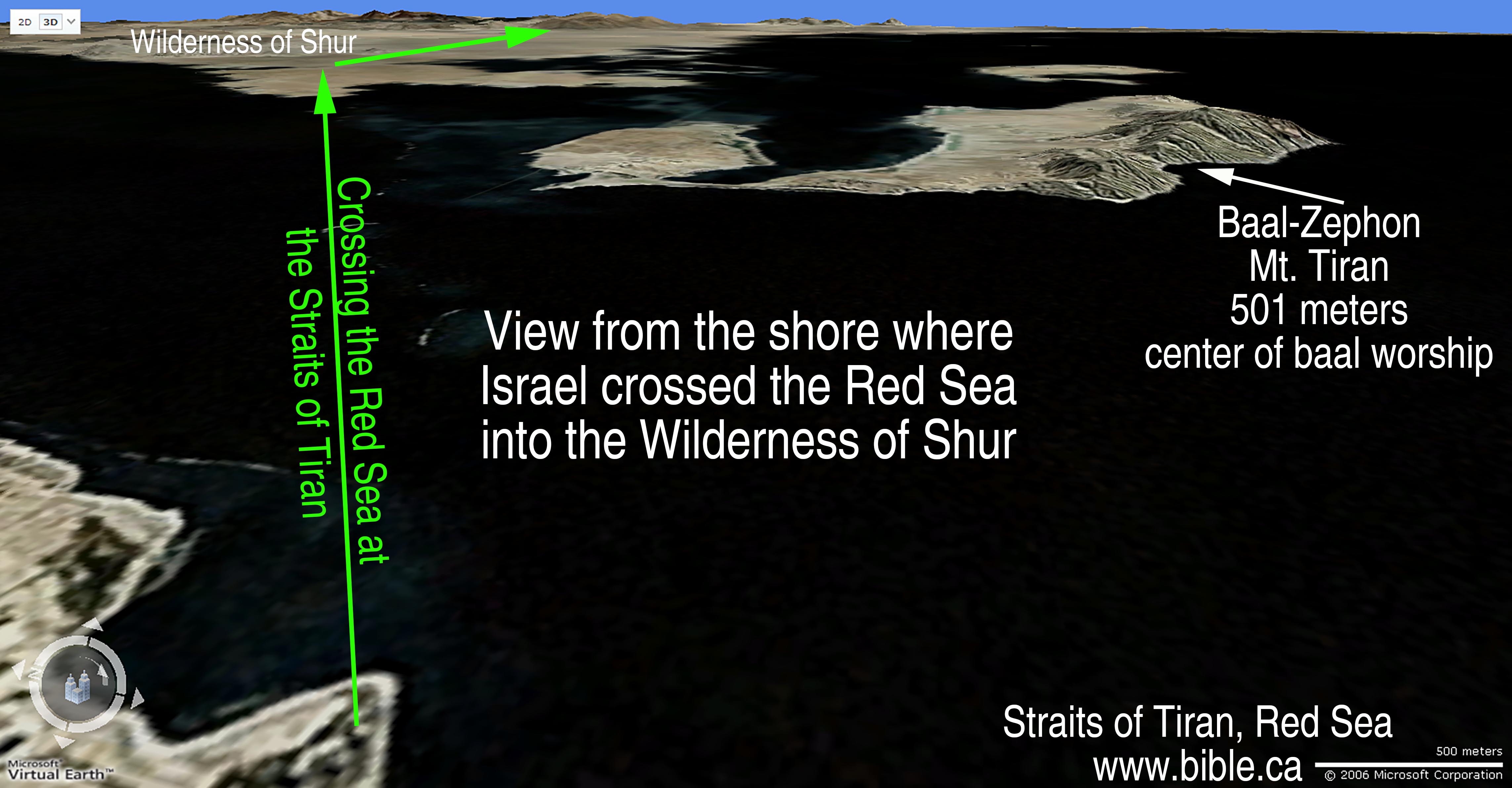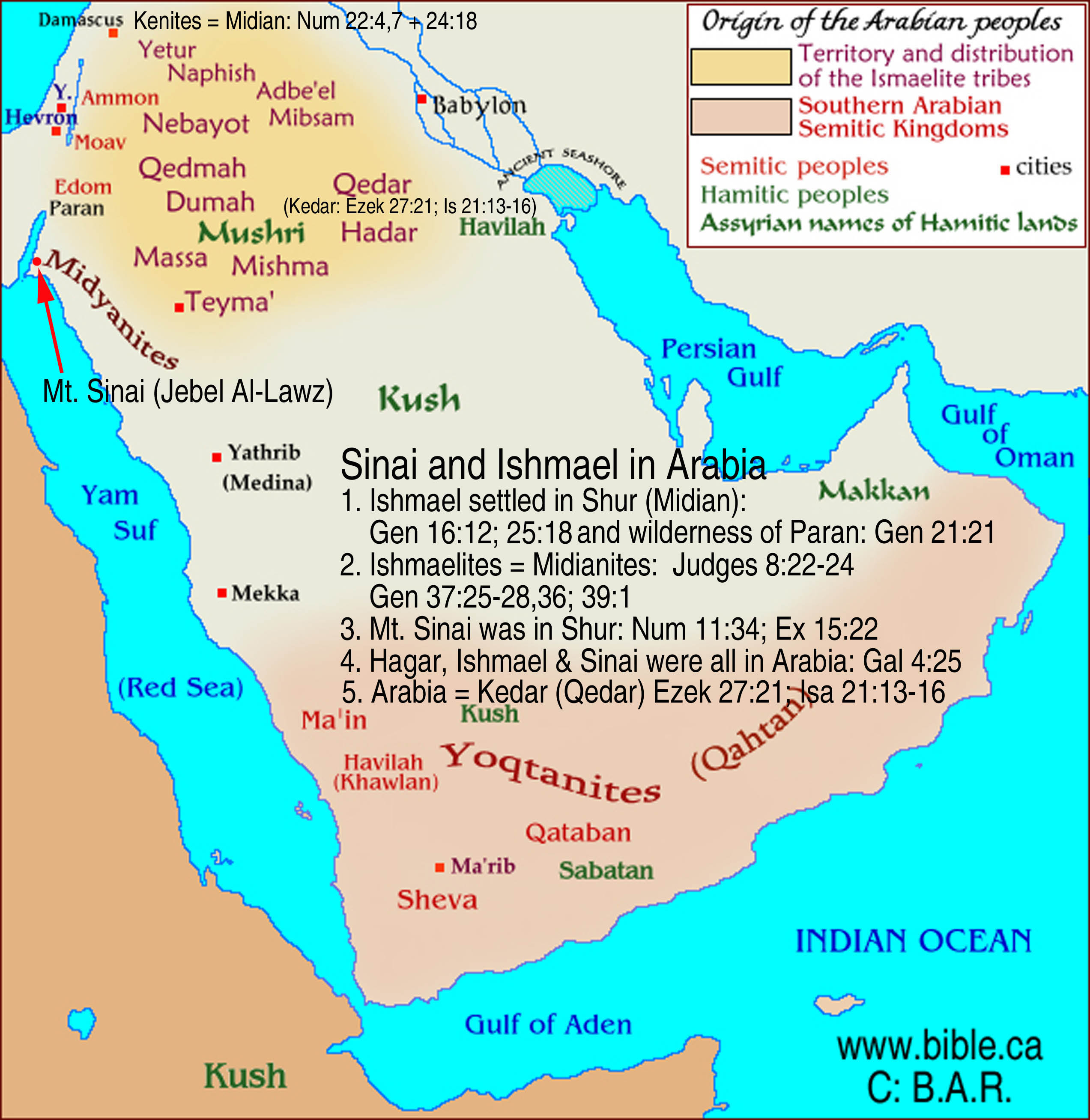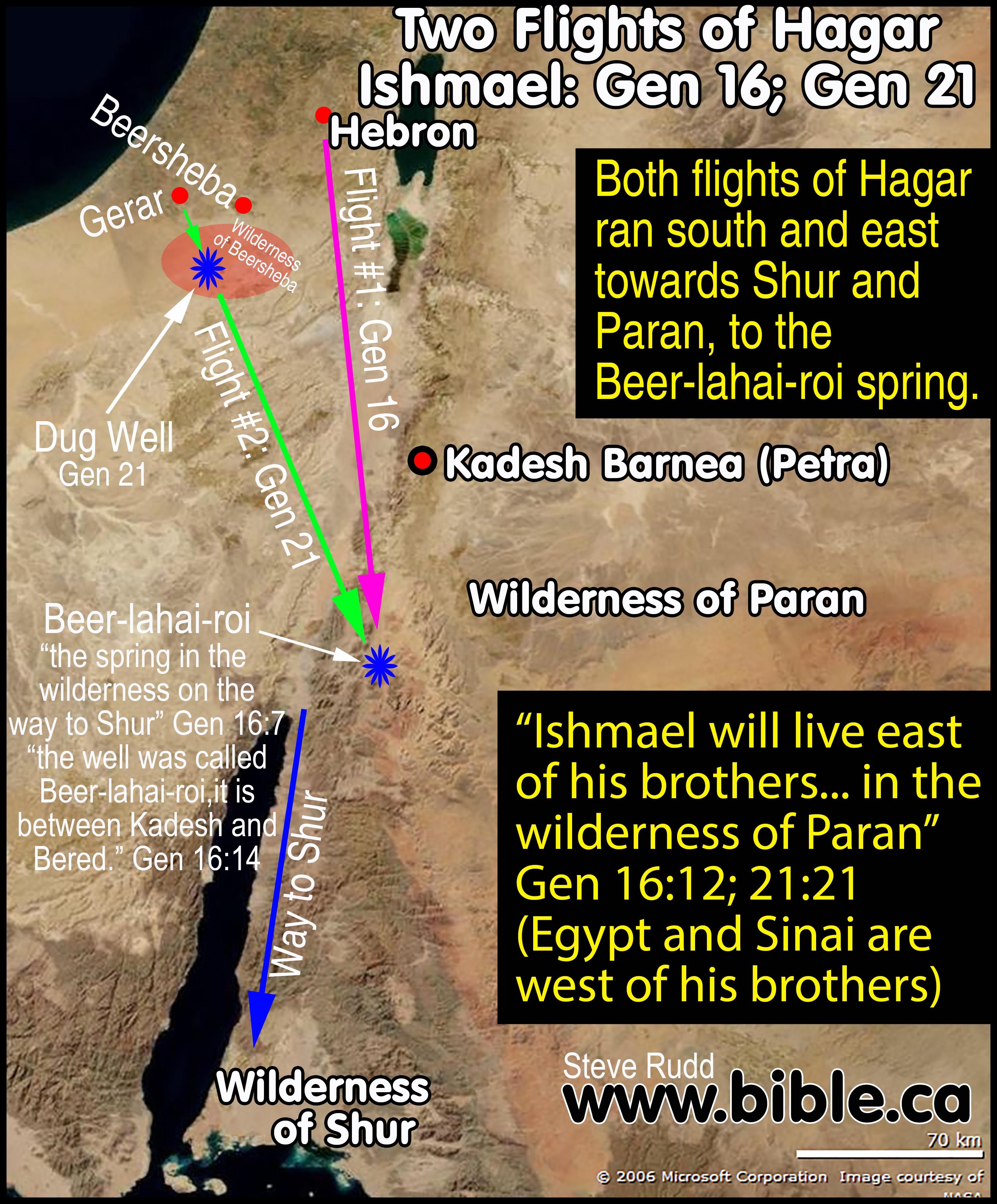The Exodus Route: Wilderness of Shur
|
Wilderness of Shur (Ishmael's land, where Mt. Sinai Located) Gal 4:25 |
"Then Moses led Israel from the Red Sea, and they went out into the Wilderness of Shur; and they went three days in the wilderness and found no water. " Exodus 15:22
|
Exodus locations:
|
Introduction:
1. The place where the Midianites, Kenites and Ishmaelites lived was in the Wilderness of Shur. The capital city of Midian was at modern Al- Bad.
a. The Midianites and the Ishmaelites intermarried and became one sect that were indistinguishable at the time Joseph was sold into Egyptian slavery in 1899 BC.
b. The Kenites are a sect of Midianites who descended from Jethro the Midianite (Moses father in law) and their traditional territory was near Midian: Judges 1:16.
2. The Wilderness of Shur proves Mt. Sinai is in Modern Saudi Arabia.
a. Gal 4:25 says that Mt. Sinai is in Arabia, where Ishmael lived and Ishmael lived in Shur.
b. The Wilderness of Shur, is the most important location for determining the exodus route.
c. It is one of only four known places in the list of 50 exodus stops: Goshen/Ramses, Wilderness of Shur, Ezion Geber, Mt. Nebo.
d. The Wilderness of Shur is where Ishmael settled and that is Transjordan and modern Saudi Arabia. The Bible tells us that Shur is the home turf of Ishmael and we know Ishmael settled near Midian which is in modern Saudi Arabia.
e. We are shocked that more people have not connected this fact. The implications are huge for the exodus route, since it places Mt. Sinai in modern Saudi Arabia. There seems to be a disconnect in the biblical world. On one hand they all know that Ishmael lived in modern Saudi Arabia, yet on the other, they say Mt. Sinai is Mt. Musa in modern Sinai Peninsula. This is a contradiction. They entered the Wilderness of Shur after crossing the Red Sea and if Shur is where historic domain of the Ishmaelites, and the Ishmaelites live east of the Gulf of Aqaba, then Mt. Sinai must be in Modern Saudi Arabia. It’s just that simple.
3. There is an element of circular reasoning that goes on in many exodus route locations. They know the Wilderness of Shur is immediately after crossing the Red Sea, so Bible maps place the Wilderness of Shur based upon where they think Israel crossed the Red Sea. After the Red Sea crossing point is chosen, then Wilderness of Shur is determined.
4. Ishmael settled "east" of the Hebrews in Shur: Shur is traditionally located beside Egypt, but this means Ishmael was West of his brothers, not east. Midianites and Ishmaelites lived in the same region and are used interchangeably in the Joseph story. This proves the traditional location of the Wilderness of Shur wrong. The Wilderness of Shur is in northern Saudi Arabia and immediately after crossing the Red sea. This proves Mt. Sinai is near the land of Midian. Abraham settled for a time in a Transjordan location between Kadesh and Shur.
5. Israel crossed the Red Sea and spent a total of 5 days in the Wilderness of Shur before they entered the Wilderness of Sin.
a. Three days travelling to Marah, then one day at Elim and one day camped by the Red Sea.
b. The Wilderness of Shur is a large vast coastal plain of 1800 sq. km. It would facilitate easy travel like the 290 km coastal plain they traveled down the east coast of the Gulf of Suez to get to the Straits of Tiran to cross the Red Sea.
6.
Wilderness of Shur described by Agatharchides of Cnidus, On the
Erythraean Sea 169 BC:

a. The entire inner coastline wraps around and is described as 500 stadium, which is 92 km which is very close to the actual measurement of the shoreline today inside the cove.
b. Immediately adjacent to the Straits of Tiran: 87a. “But we shall take up the remaining portion, the opposite shore which joins Arabia, and describe it, beginning again from the innermost recess. This is named Poseideion and was founded by Ariston, who was dispatched by Ptolemy to explore Arabia as far as the ocean and established there an altar dedicated to Poseidon Pelagaeus. Immediately after the innermost recess is a place by the sea which is exceptionally highly regarded by the natives because of the benefit derived from it. The place is named Palm-Grove, and it contains an abundance of this kind of tree which is extraordinarily fruitful and particularly conducive to pleasure and luxury. All the nearby surrounding country, however, lacks springs and is fiery hot because of its southern orientation. For this reason the barbarians rightly designated as sacred the place that supports trees and that, although situated in the midst of the most desolate regions, supplied their food. For not a few springs and streams emerge in it that are not inferior in their coldness to snow. These make the land on either side of them green and pleasant in every way. There is also an ancient altar that is made of hard stone and bears an inscription in lettering that is archaic and unintelligible. The sanctuary is cared for by a man and a woman who occupy their sacred office for life. The inhabitants of this place are long-lived and make their beds in the trees because of their fear of wild animals. (Agatharchides of Cnidus, On the Erythraean Sea 169 BC, translated by Stanley M. Burstein, 1989, book 5, fragment 87a. Diodorus 49 BC, 3.42.1-4)
c. Immediately adjacent to the Straits of Tiran: “The portion of the interior that is visible from the Palm-Grove is filled with rocky peaks of various heights [visible in the distance towards Mt. Lawz], but the part that extends towards the sea is narrow and long. (Agatharchides of Cnidus, On the Erythraean Sea 169 BC, translated by Stanley M. Burstein, 1989, book 5, fragment 88. Photius 897 AD, Cod. 250.86, 457a)
d. Central plain of the Wilderness of Shur: “After these places there is a well-watered plain which, because of the streams [wadis] that flow through it everywhere, grows dog's tooth grass, Lucerne and also lotus the height of a man. Because of the abundance and excellence of the pasturage it not only supports flocks and herds of all sorts in unspeakably great numbers but also wild camels and, in addition, deer and gazelles. In response to the abundance of animals which breed there, crowds of lions, wolves and leopards gather from the desert. Against these the herdsmen are compelled to fight day and night in defense of their flocks. Thus, the advantage of the country is the cause of misfortune to its inhabitants because Nature generally gives men together with good things those that are harmful. (Agatharchides of Cnidus, On the Erythraean Sea 169 BC, translated by Stanley M. Burstein, 1989, book 5, fragment 91b. Diodorus 49 BC, 3.43.6-7)
e. Inner curved coastline on the southern boundary of the Wilderness of Shur is 98 km: “Sailing past these plains one encounters a bay which is of a paradoxical character. For it narrows to a point as it penetrates into the heart of the country. In length it extends for five hundred stades [or Stadion = 98 km’ and is bounded on all sides by cliffs of amazing size. Its mouth is twisting and difficult of egress for a rock, which juts out to sea, blocks the entrance and make it impossible to sail in or out of the gulf. Further, when the current increases and the winds change, waves crash on the rocky shore and create eddies everywhere around the projecting rock. The people who inhabit the country beside the gulf, who are named the Banizomenes, support them-selves by hunting and eating the flesh of land animals. A very sacred temple has been established there which is highly revered by all the Arabs.” (Agatharchides of Cnidus, On the Erythraean Sea 169 BC, translated by Stanley M. Burstein, 1989, book 5, fragment 92b. Diodorus 49 BC, 3.44.1-2)
7. Finally, the Chronicle of Theophanes was a yearly diary of events from the 3rd to 9th century AD and was written in 813 AD. For the diary of world events in AD 629, Theophanes calls Muhammed the Arab “leader and false prophet of the Saracens … descendant of Ishmael” and the Arabs who populated the new Islamic religion as Ishmaelites.
a. The Chronicle of Theophanes confirms the Bible in that Saudi Arabia was the homeland of Ishmael.
b. The Chronicle of Theophanes confirms the Bible that the “Wilderness of Shur” and the land of “Shur” were in North West Saudi Arabia opposite the Straits of Tiran.
c. AD 629: "Muhammad [Mouamed], leader of the Arabs (9 years), [9th year Sergius, bishop of Constantinople (29 years), 22nd year Zacharias, bishop of Jerusalem (22 years), 22nd year George, bishop of Alexandria (14 years), 12th year.] In this year died Mouamed [i.e. Muhammed, founder of Islam], the leader and false prophet of the Saracens, after appointing his kinsman Abu Bakr [Aboubacharos] to his chieftainship. At the same time, his repute spread abroad and everyone was frightened. At the beginning of his advent the misguided Jews thought he was the Messiah who is awaited by them, so that some of their leaders joined him and accepted his religion while forsaking that of Moses, who saw God. Those who did so were ten in number, and they remained with him until his murder. But when they saw him eating camel meat, they realized that he was not the one they thought him to be, and were at a loss what to do; being afraid to abjure his religion, those wretched men taught him illicit things directed against us, Christians, and remained with him. I consider it necessary to give an account of this man's [Muhammad] origin. He was descended from a very widespread tribe, that of Ishmael, son of Abraham; for Nizaros, descendant of Ishmael, is recognized as the father of them all. He begot two sons, Moudaros and Rabias. Moudaros begot Kourasos, Kaisos, Themimes, Asados, and others unknown. All of them dwelt in the Midianite desert and kept cattle, themselves living in tents. There are also those farther away who are not of their tribe, but of that of Iektan, the so-called Amanites, that is Homerites. And some of them traded on their camels. Being destitute and an orphan, the aforesaid Mouamed decided to enter the service of a rich woman who was a relative of his, called Chadiga, as a hired worker with a view to trading by camel in Egypt and Palestine. Little by little he became bolder and ingratiated himself with that woman, who was a widow, took her as a wife, and gained possession of her camels and her substance. Whenever he came to Palestine he consorted with Jews and Christians and sought from them certain scriptural matters. He was also afflicted with epilepsy. When his wife became aware of this, she was greatly distressed, inasmuch as she, a noblewoman, had married a man such as he, who was not only poor, but also an epileptic. He tried deceitfully to placate her by saying, 'I keep seeing a vision of a certain angel called Gabriel, and being unable to bear his sight, I faint and fall down.' Now, she had a certain monk [named one of these: Sergius, Bahira, Nastur] living there, a friend of hers (who had been exiled for his depraved doctrine), and she related everything to him, including the angel's name. Wishing to satisfy her, he said to her, 'He has spoken the truth, for this is the angel who is sent to all the prophets.' When she had heard the words of the Aboubacharos, whom he left false monk, she was the first to believe in Mouamed [Muhammad] and proclaimed other women of her tribe that he was a prophet. Thus, the report spread from women to men, and first to [Abu Bakr, 1st Muslim Caliph] Aboubacharos, whom he left as his successor. This heresy prevailed in the region of Ethribos, in the last resort by war: at first secretly, for ten years, and by war another ten, and openly nines He taught his subjects that he who kills an enemy or is killed by an enemy goes to Paradise; and he said that this paradise was one of carnal eating and drinking and intercourse with women, and had a river of wine, honey, and milk, and that the women were not like the ones down here, but different ones, and that the intercourse was long-lasting and the pleasure continuous; and other things full of profligacy and stupidity; also that men should feel sympathy for one another and help those who are wronged." (Chronicle 629 AD of Theophanes, 813 AD)
A. The Exodus Route: Three days into the Wilderness of Shur:
- "Then Moses led Israel from the Red Sea, and they went out into the Wilderness of Shur Exodus 15:22
- They crossed the Red Sea on a Sunday, then spent three days (Mon - Wed) travelling 67 km in the Wilderness of Shur until they came to Marah.
- The Wilderness of Etham, found only in Num 33:8, is a gloss not found in the LLX, only the Massoretic text.) The Wilderness of Etham is the same, therefore as the Wilderness of Shur.
|
Overview map with all the locations between the Red Sea crossing and Mt. Sinai with distances and times. |
|
|
Aerial view of the Wilderness of Shur and the exodus route. They went three days in the Wilderness of Shur and came to Marah: Num 33:8 |
|
|
Jethro's hometown, Mt. Sinai and the Wilderness of Shur. Moses tended his flocks near Midian when he saw the burning bush at Mt. Sinai. |
|
|
Marah and Elim which are both in the Wilderness of Shur. |
|
|
Wildernesses in the land of Midian. |
|
|
Wilderness of Shur from Egypt where they crossed the Red Sea at the Straits of Tiran. |
B. The Bible says Ishmael lived in Paran and Shur
- Gal 4:25 says that Mt. Sinai is in Arabia, where Ishmael lived.
- "Ishmael will be a wild donkey of a man, His hand will be against everyone, And everyone's hand will be against him; And he will live to the east of all his brothers."Genesis 16:12
- "Ishmael lived in the Wilderness of Paran, and his mother took a wife for him from the land of Egypt." Genesis 21:21
- "Ishmaelites settled from Havilah to Shur which is east of Egypt as one goes toward Assyria; he settled in defiance of all his relatives." Genesis 25:18
- The Ishmaelites are grouped with other Transjordan tribes: "The tents of Edom and the Ishmaelites, Moab and the Hagrites; Gebal and Ammon and Amalek" Psalm 83:6
C. Archeologists, historians say Ishmaelites lived Transjordan:
D. Similarity of territory between Ishmaelites and Amalekites:
- "Ishmael settled from Havilah to Shur which is east of Egypt as one goes toward Assyria" Gen 25:18
- "So Saul defeated the Amalekites, from Havilah as you go to Shur, which is east of Egypt. " 1 Samuel 15:7
- "the Amalekites ... were the inhabitants of the land from ancient times, as you come to Shur even as far as the land of Egypt." 1 Samuel 27:8
- Detailed outline on the Amalekites.
|
Gen 25:18 |
Ishmael settled |
from Havilah to Shur |
which is east of Egypt as one goes toward Assyria |
|
1 Samuel 15:7 |
Amalekites |
from Havilah as you go to Shur |
which is east of Egypt |
|
1 Samuel 27:8 |
Amalekites from ancient times |
as you come to Shur |
even as far as the land of Egypt |
E. Ishmaelites and Midianites are synonymous and interchangeable:
- Midianites and Ishmaelites are used interchangeably in the story of selling Joseph to Egypt: Gen 37:25-28,36; 39:1; Judg 8:22-24.
- Midian was Abraham's son through Keturah Gen 25:2; Ishmael was Abraham's son through Hagar. Although originally different sons of Abraham, the Midianites and Ishmaelites melded into a single group of people from the same region.
- "Then they sat down to eat a meal. And as they raised their eyes and looked, behold, a caravan of Ishmaelites was coming from Gilead, with their camels bearing aromatic gum and balm and myrrh, on their way to bring them down to Egypt. Judah said to his brothers, "What profit is it for us to kill our brother and cover up his blood? "Come and let us sell him to the Ishmaelites and not lay our hands on him, for he is our brother, our own flesh." And his brothers listened to him. Then some Midianite traders passed by, so they pulled him up and lifted Joseph out of the pit, and sold him to the Ishmaelites for twenty shekels of silver. Thus they brought Joseph into Egypt. " Genesis 37:25-28
- "Meanwhile, the Midianites sold him in Egypt to Potiphar, Pharaoh's officer, the captain of the bodyguard." Genesis 37:36
- "Now Joseph had been taken down to Egypt; and Potiphar, an Egyptian officer of Pharaoh, the captain of the bodyguard, bought him from the Ishmaelites, who had taken him down there. " Genesis 39:1
- The Midianites were also called Ishmaelites who oppressed Israel 7 years and Gideon beat them in battle: "Then the men of Israel said to Gideon, "Rule over us, both you and your son, also your son's son, for you have delivered us from the hand of Midian." But Gideon said to them, "I will not rule over you, nor shall my son rule over you; the Lord shall rule over you." Yet Gideon said to them, "I would request of you, that each of you give me an earring from his spoil." (For they had gold earrings, because they were Ishmaelites.) " Judges 8:22-24
- Kedar was the son of Ishmael, who intermarried with the Midianites and lived south east of the Dead Sea. "These are their genealogies: the firstborn of Ishmael was Nebaioth, then Kedar" 1 Chronicles 1:29
- Ishmael settled in Shur and the Wilderness of Paran: Gen 16:12; 21:21; 25:18
F. Ishmaelites lived Transjordan, not in the modern Sinai Peninsula: Gen 16:12
|
"He will be a wild donkey of a man, His hand will be against everyone, And everyone's hand will be against him; And he will live to the east of all his brothers." Gen 16:12 |
1. The two flights Hagar started from the same basic area and ended up at the same place: Flight one from Hebron and flight two from Gerar in the land of Abimelech, king of the Philistines. The flight path heads towards the same "Beer-lahai-rio" spring of water in the Wilderness of Paran east of the southern Arabah valley.
2. Twice Hagar fled from Sarah.
a. First in Gen 16 where she ran to a spring of water called "Beer-lahai-rio" that was in the wilderness on the way to Shur between Kadesh and Bered. God told Hagar to return to Sarah and submit to her.
b. The second flight of Hagar in Gen 21 is about 13 years later after Isaac was born and Sarah banished Hagar from Gerar in the land of the Philistines. Abraham moved from Hebron (Gen 18:1) to Gerar (Gen 20:1). Hagar flees Sarah from Gerar (not Hebron as you say) and heads towards Elat because she is found in the Wilderness of Beersheba (Gen 21:14; Gal 4). This direction leads towards Elat and is a perfect fit for Shur being in Saudi Arabia. In the story of Joseph being sold to the Ishmaelites, the narration describes them interchangeably as Midianites multiple times. This proves that Ishmael lived in Midian because they had intermarried. Find Ishmael and you find Midian and Sinai. The modern Sinai peninsula has always been Egyptian Territory. The border of Egypt and Israel is the Wadi El Arish. (Gen 15:18; 1 Ki 8:65; 2 Ki 24:7; 2 Chr 7:8; Isa 27:12; 2 Chr 9:26; 1 King 4:21). At the time of Joshua "the lot of Simeon bordered upon Egypt and Arabia" (Josephus, Antiquities 5.78).
3. We know that at the time of the Exodus, Edomites were Transjordan. Only after the Assyrian and Babylonian captivities 722 - 586 BC, Edom moved into Judah's Territory. Since Kadesh was on the border of Edom, this places Kadesh Transjordan. This is where everyone before 1881 AD was looking for Kadesh. Josephus said Kadesh Barnea was at Petra.
4. The first flight from Hebron: Gen 16: Hagar ran straight towards the way to Shur, which starts at Ezion Geber (modern Elat) and goes south down the east side of the Gulf of Aqaba. We don't know for sure where this spring or Bered are located. However, between Kadesh Barnea and the way to Shur give us the general area. Since both Kadesh Barnea and the Wilderness of Shur are Transjordan, we can safely place the "Beer-lahai-rio" spring somewhere within the Wilderness of Paran.
5. After Hagar returned to submit to Sarah from Beer-lahai-rio, it seems that Abraham packs up and moves to this very spring of water. "Now Abraham journeyed from there toward the land of the Negev, and settled between Kadesh and Shur; then he sojourned in Gerar. " Genesis 20:1 The text says that Abraham settled between Kadesh Barnea and Shur. This is Transjordan and in the same basic area as the Beer-lahai-rio spring. Perhaps Hagar told Abraham about it. Abraham packs up and moves again, this time back to the coast to Gerar where the Philistines dwelt and where Abimelech was king. Gerar was Abraham's home for "many days".
6. The second flight Gerar: Gen 21: Hagar was wandering in the wilderness south of Beersheba when God opened her eyes to a dug well of water. The Bible then says that "He lived in the Wilderness of Paran" Genesis 21:21.
7. What is amazing is that both times, Hagar ran the same basic direction and in both texts, she ended up in the same place: the Wilderness of Paran. Probably at the very spring of water she discovered and brought Abraham back to see. She probably returned to the Beer-lahai-rio and raised Ishmael near by in the Wilderness of Paran, south of Kadesh Barnea, north of Shur.
8. The Muslims, of course, re-write history and say that the story of Hagar and Ishmael at the well of Gen 21, was not in near Beersheba, but at the Zam Zam well in Mecca. They also re-write history and say that Abraham sacrificed Ishmael on the altar, not Isaac. Allah was originally the pagan moon god named "Hubal". Like Akhenaton, Muhammad chose one god, from among hundreds of pagan gods, to be his one monotheistic god. Both merely repackaged polytheism and called it monotheism. We have identified 12 key similarities between the religious reforms of Akhenaton and Muhammad.
9. Gen 16:2 says, "he will live to the east of all his brothers". This places the territory of Ishmael Transjordan and not in the modern Sinai Peninsula. The modern Sinai is west of Israel, not east.
10. Other Bible verses tell us that Ishmael lived Transjordan between the Gulf of Aqaba and Babylon: Gen 25:18; 16:12; 21:21. Havilah is a land near Babylon connected with the Garden of Eden: "The name of the first is Pishon; it flows around the whole land of Havilah, where there is gold." Genesis 2:11
G. Ishmaelites absent during the conquest:
- Bible maps currently place the Wilderness of Paran, where Ishmael grew up and lived, within the promised land, east of the wadi el-Arish which is the border between Israel and Egypt. This is because Ein el-Qudeirat is where they think mistakenly Kadesh Barnea is located. Since Kadesh Barnea is in the Wilderness of Paran, and since Kadesh is also 20 km inside the wadi el-Arish within Judean territory, that makes the Wilderness of Paran also inside the land belonging to the tribe of Judah. Overlooking how ridiculous it is to place Kadesh Barnea at Ein el-Qudeirat since this means Israel spent 38 years "in the wilderness", inside the promised land, but they didn't know it. We will now deal with the problem of placing the Ishmaelites within the promised land.
- The proof that the Ishmaelites lived entirely Transjordan, is the fact that during the conquest, the Hebrews never fought or battled them.
- If the Ishmaelites did live in the territory of Judah, where current maps place the Wilderness of Paran, why did Joshua, David or Solomon never run into them? In fact, after entering the promised land, the Ishmaelites are only mentioned four times in the Bible. One of these four times, the Ishmaelites are equated to be the same as Midianites who lived in Modern Saudi Arabia: Judges 8:24.
- This also shows that the Ishmaelites did not live in the north section of the modern Sinai Peninsula, as would be expected for those who place the Wildernesses of Paran and Shur in that area.
H. Ishmaelites, Shur, Midian and Mt. Sinai: Gal 4:25
- Gal 4:25 says that Mt. Sinai is in Arabia, where Ishmael lived and Ishmael lived in Shur.
- Remember that the Ishmaelites became one tribe with the Midianites who lived in the Wilderness of Shur at modern Al Bad.
- Although the Ishmaelites were nomads who roamed wide areas, their home has always been associated with a Transjordan homeland, east of the Gulf of Aqaba and Dead Sea.
- Although the Ishmaelites traveled extensively between Babylon and Egypt, there is no evidence that the Ishmaelites would ever consider the modern Sinai Peninsula their land.
- The Modern Sinai peninsula was always controlled by Egypt
in the Old Testament.

I. How the traditional choice for Wilderness of Shur fails:
- The traditional location on most Bible maps for the Wilderness of Shur is due east of the modern Suez Canal. Traditional location on most Bible maps for the Wilderness of Paran is west of Beersheba and Ein el-Qudeirat. These two areas have never been considered home turf for the Ishmaelites. The fact they were nomads doesn't change the fact that their traditional territory has always been Transjordan.
- The Wilderness of Paran is located beside Ein el-Qudeirat (current choice for Kadesh Barnea), yet both are within the promised land. This means that when Israel thought they spent 38 years in the wilderness, they were actually in the promised land all along. Since the Wilderness of Paran is where the Ishmaelites called their homeland, we should find some conflict with them during the conquest, but we don't.
- The entire modern Sinai Peninsula is part of Egypt and under Egyptian control. The eastern border of Egypt is the wadi El-Arish. Ishmaelites would certainly not attempt to claim this as a homeland. This same wadi El-Arish (river of Egypt) was also the historic border of the promised land between Egypt and Israel: Gen 15:18.
Conclusion:
- We have definitively proven that Mt. Sinai is in modern Saudi Arabia by associating the Wilderness of Shur with the homeland of the Ishmaelites.
- We have the witness of archeology that agrees that the Ishmaelite home territory was Transjordan.
- Travelling through the Egyptian controlled modern Sinai Peninsula does not constitute home territory any more than when a salesman walks into a store owned by another.
- The Ishmaelites traded with the Egyptians within Egyptian territory.
- We have the witness of the Old Testament that the Ishmaelites lived in the land of the Midianites, in modern Saudi Arabia, since the two tribes are used interchangeably in several different texts.
- The two flights of Hagar (Gen 16; Gen 21) headed towards modern Saudi Arabia. Both times Hagar ran towards the land where she would raise Ishmael. Find the place of Hagar and Ishmael and you have located Mt. Sinai: Gal 4:25.
- The Ishmaelites and Midianites intermarried to become one people when Joseph was traded to the Ishmaelites, 430 years before the Exodus. Everyone knows that the Midianites lived in Midian in modern Saudi Arabia. In fact, Jethro lived in Midian and this is where Moses tended his flocks. A simple reading of the text confirms that Moses was near Midian when he was tending the sheep and saw the burning bush at Mt. Sinai (Jebel Al-Lawz)
- We have the witness of the New Testament in Gal 4:25 flat out stating that Mt. Sinai is in Arabia... where the Ishmaelites lived.
By Steve Rudd: Contact the author for comments, input or corrections.
